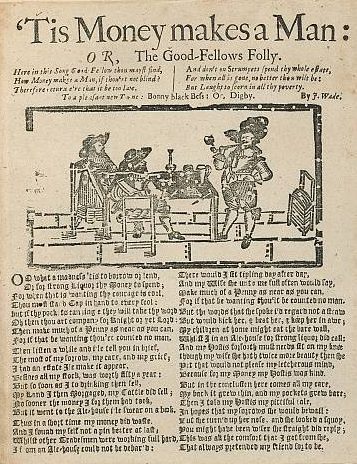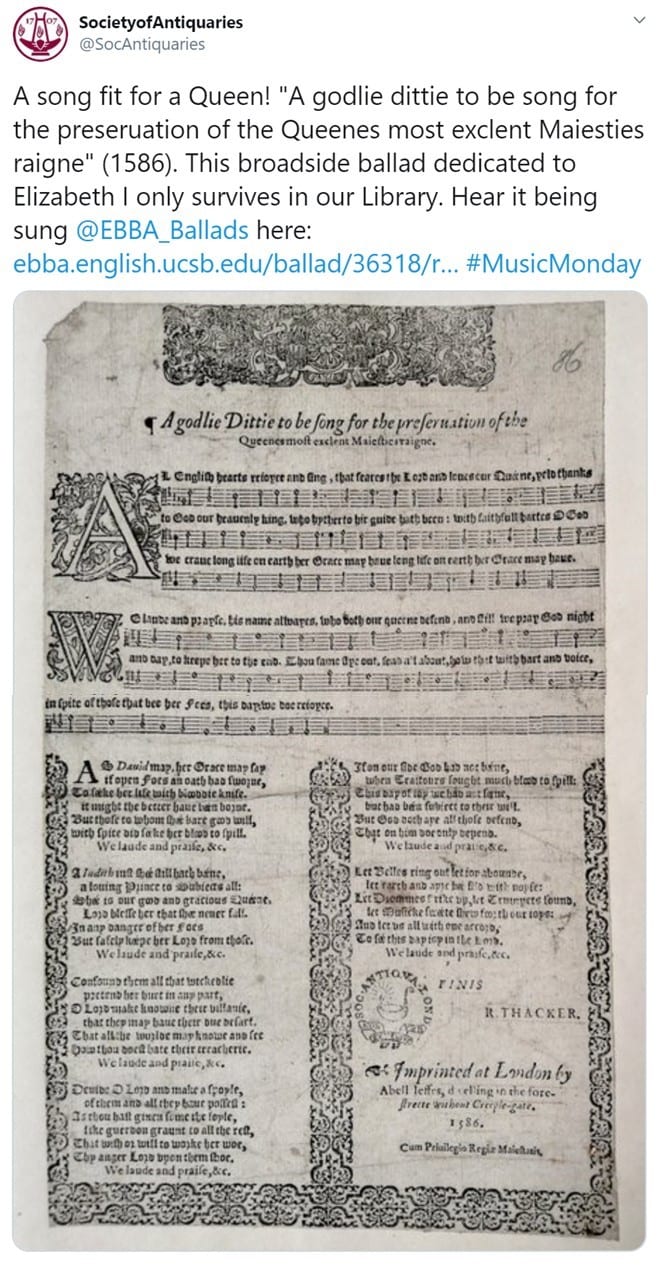“A pleasant jigg betwixt Jack and his mistress,” from the English Broadside Ballad Archive. Original held by the National Library of Scotland. Read the text or listen to it sung at https://ebba.english.ucsb.edu/ballad/32821.
NEH Award Supports UCSB and DataLab Collaboration to Complete 17th Century “Street Poetry” Digitization Project
The DataLab at the UC Davis Library is collaborating with the English Department at the University of California, Santa Barbara on a three-year, $360,000 grant from the National Endowment for the Humanities to support the most comprehensive digital humanities project of its kind in the world — the English Broadside Ballad Archive.
The archive was founded in 2003 by Professor Patricia Fumerton in the English Department at at UC Santa Barbara, which serves as the archive’s home institution. The DataLab’s Executive Director, Carl Stahmer, joined the project in 2007 while working as a research scientist at UCSB, and has served as the archive’s Associate Director since 2008. The current award includes funding for the DataLab to enhance both the design and function of the archive’s user interface, adding advanced machine learning analytics to the system. “This work really puts UC Davis at the forefront of work that integrates data science and the humanities,” according to Stahmer. “It is true interdisciplinary work.”
Understanding the foundation of humanities through broadside
The EBBA project focuses on making English broadside ballads of the 17th century fully accessible as texts, art, music, and cultural records. These ballads, which are often referred to as English “street literature or poetry” — “the memes of their day” — are significant because they authentically capture life at a pivotal time in history.

The original copy of “Tis Money Makes a Man” is at the Houghton Library at Harvard University. Find the full broadside and recorded music at https://ebba.english.ucsb.edu/ballad/34705.
“They were the newspapers of their time, and sometimes the salacious entertainment, as well,” Stahmer said. “The great works of literature that people typically read from this era only reflect the ideas of a certain segments of society from the time. These ballads are much more representative of what it was like to be a human being living in 17th-century England.”
Understanding life in the 17th century matters because it was the dawning of modern-day humanities, according to Stahmer. “All the topics we still care about today were being defined and worked out in that moment” as masses of people moved from farms to cities, he explained.
“A large number of the ideological constructs that influence our lives today were invented in the 17th century,” Stahmer said. “Democracy, the right to privacy, the ideas of gender and race — these are the things that, to this day, define our engagement with the world. Understanding how they came to be gives us the best chance moving forward to understand why we make decisions that we do and why the world works the way it does.”
A team effort
The EBBA project is a UC Santa Barbara-UC Davis partnership supported by a team of 20 to 30 individuals including undergraduate, graduate and post-doc students. The project requires a large team because the process for deciphering and archiving these 400-year-old materials is labor intensive. English broadside ballads are written in black-letter print, which is difficult for both humans and computer algorithms to read. As such, every ballad must go through a double-keyed transcription where any disparities are flagged and reviewed by the team of experts. Additionally, many ballads are neither dated nor have an author, so teams must find and research historical markers within the text to establish date ranges on the pieces.
Stahmer and his DataLab team have built state-of-the-art technology that allows each element of the ballad — text, imagery and music — to be made accessible through advanced online search functions, including the creation of sophisticated image-matching software called Arch-V, or Archive Vision, that can search for and identify images that are similar — though not identical — to one another, a valuable tool given the natural variations in the woodcut images used in broadsides. (Arch-V received major grant funding from the Getty Foundation in 2019; learn more here.)

The Arch-V element of the EBBA project “makes this year’s award particularly exciting,” according to Nadina Gardner, director of the division of preservation and access at NEH.
“EBBA creates the highest level of digital access to the historical record through its granular cataloging and imaging of the broadsides themselves,” Gardner said. “Through adherence to the best practices for cataloging, digitization, transcription, and encoding — as well as innovative uses of emerging search and image-matching software — EBBA captures both the content and the form of the ballads, rendering the ballads and thereby a slice of common life in early modern England accessible to various audiences, not just to scholars already steeped in history.”
An international collaboration
A unique aspect of the EBBA project is that neither UC Santa Barbara nor UC Davis own any of the materials in the collection. As such, the project’s success has been completely reliant on collaborations with colleagues and institutions around the globe.
To build the collection, EBBA team members from both campuses have had to travel the world in search of ballad collections and then convince the owners of those collections to let the EBBA team digitize and share their collections online. Over the years, the EBBA team has forged partnerships with numerous universities and libraries, including Cambridge University, University of Glasgow, Harvard University, the Library of Scotland, the British Library and the Huntington Library in Pasadena, California.
NEH says EBBA’s international network and collaboration efforts have become the gold standard for other archival projects.
“The global collaboration that EBBA has maintained for a decade and a half remains a model for other projects whose archives are housed across national borders,” Gardner said.
Unearthing lost elements
The EBBA project has also unearthed several previously lost segments of this important period of English literature.

Tweet from the Society of Antiquaries in London linking to EBBA’s musical recording.
For example, the EBBA musicology team, currently led by Dr. Eric Bell at UC Santa Barbara, has captured and recreated the musical elements associated with each ballad. Once a ballad is transcribed, a professional musicologist composes the ballad’s song, which is then performed by Renaissance singers and recorded. The musicologist works with the data scientists to create a MIDI file, or musical data map, that is archived with the broadside, thereby bringing another important dimension of the ballad to life.
In addition, scholars previously thought there were between 6,000 to 7,000 English ballads in existence. The EBBA team has discovered and catalogued nearly 10,000 broadside ballads and made them fully accessible online. A few thousand more ballads are yet to be catalogued. The NEH grant will allow these remaining works to be digitized and archived by a team at UC Santa Barbara, completing the project, in addition to supporting the creation of a new website to make the collection more easily accessible to the public. The first version of the new site is scheduled to launch the week of September 14.
“At the conclusion of this grant, EBBA will be a complete archive,” Stahmer said. “That matters because then you know you are looking at everything. Once that happens, EBBA will be a comprehensive tool that scholars can use to make even more discoveries and have their questions answered.”
Because of the EBBA team’s meticulous metadata, rigorous standards, and careful encoding, this project “will, we believe, have lasting impact,” according to Gardner. NEH has made seven awards to EBBA since it began supporting the project in 2006.
“Too often the digital is associated with the ephemeral,” Gardner said, “but projects like EBBA show us that the historical record remediated in digital environments can be built to last.”
Media Contact
- Jessica Nusbaum, UC Davis Library, cell 415-548-5377, jlnusbaum@ucdavis.edu